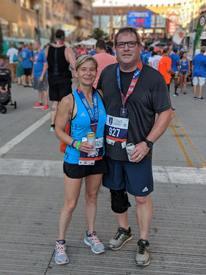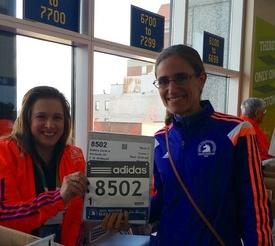Same style of shoes?
Options

SKME2013
Posts: 704 Member
Apologies for bombarding you with a second question today, but this has been bugging me and the info on the web is not clear.
I have my running shoes Asics Gel Nimbus 16 which were suggested by the running room after assessing my gait/feet. I love them and I do all my longer runs in them. I have more than one pair and I do alternate them. I also throw them out after a certain mileage.
Now I was wondering if I would benefit from running occassionally in a more minimalist shoe? I got the Nike Free 5.0 which has a toe/ heel raise of just 6mm versus my Asics which have 14mm. Does it make sense for training purposes to alternate between different styles of shoes?
Thanks
Stef.
I have my running shoes Asics Gel Nimbus 16 which were suggested by the running room after assessing my gait/feet. I love them and I do all my longer runs in them. I have more than one pair and I do alternate them. I also throw them out after a certain mileage.
Now I was wondering if I would benefit from running occassionally in a more minimalist shoe? I got the Nike Free 5.0 which has a toe/ heel raise of just 6mm versus my Asics which have 14mm. Does it make sense for training purposes to alternate between different styles of shoes?
Thanks
Stef.
0
Replies
-
Well, the minimalist/barefoot people will say that training in a flatter shoe will help you develop a better stride. That being said, I'm not sure that would work for something cushioned like the Nike Free that also still has some heel drop. It probably wouldn't hurt to do a mile or two in them and see how it feels / if you're sore afterwards. I would be worried about developing tendinitis, though, since the Free might not force you into a good stride like, say, Vibrams would. Everyone's different, though -- just because I wouldn't do it doesn't mean it can't work for you
 0
0 -
Doing this has the potential to leave you injured. But then it again, it might not. Is there a clear benefit to it? Not as far as I'm concerned.0
-
Apologies for bombarding you with a second question today, but this has been bugging me and the info on the web is not clear.
I have my running shoes Asics Gel Nimbus 16 which were suggested by the running room after assessing my gait/feet. I love them and I do all my longer runs in them. I have more than one pair and I do alternate them. I also throw them out after a certain mileage.
Now I was wondering if I would benefit from running occassionally in a more minimalist shoe? I got the Nike Free 5.0 which has a toe/ heel raise of just 6mm versus my Asics which have 14mm. Does it make sense for training purposes to alternate between different styles of shoes?
Thanks
Stef.
Your calves are going to hurt for weeks. Good or bad for you? Who knows?
Other than that just ease into it and see if you like them. I wouldn't do long runs in them until you're used to the heel drop.0 -
If the shoes/heel drop you have work for you, I wouldn't recommend switching from a 14mm drop to a 6mm drop. I switched from a traditional trainer (Saucony Progrid Omnis, with a 14-20 mm drop, IDK what it was) to a "minimal" trainer (Saucony Kinvara, 4mm drop) after repeated bouts of tendinitis in my knees. I found that a shoe that weighed less helped my knees TREMENDOUSLY (my feet flick outward when I run, and so heavier shoes pull more on my knees with each stride). I switched shoes after recovering from some vicious tendinitis flare ups, but it still took me a couple months to run well in them. I remember that my feet and ankles would ache because I had to use those muscles differently.
Therefore, if what you have is working and you have no reason to switch, I wouldn't take the time to do so. I also don't think that rotating between 14mm and 6mm will be particularly useful in training, but I have no personal experience to draw on for that.0 -
I have been running in Asics Kayanos for 10+ years and never had an injury (I did get a stress fracture in my metatarsal bone early last year, but that was most likely due to a prolonged use of prednisone and not my shoes). Anyway, In August of last year I purchased a pair of Kinvaras because they were on sale and I wanted to see what all of the hype was about. I think I have run a total of about 10 miles in them. I'm not sure I can ever (or want to) adjust to the difference in my running style with these shoes. That's just my personal experience. I have experimented with a variety of shoes over the years and always come back to my good old favorites. I guess I subscribe to the old adage, if it ain't broke, don't fix it.0
-
I don't know if there is any particular benefit to alternating between different styles of shoe, but as the Nimbus 16 are neutral shoes you might find you are okay in the Frees too. I ran in Brooks Defyance for a couple of years but wanted lighter shoes to race shorter distances in and because I am not very heavy and run with a mid/forefoot strike and a neutral gait, I didn't experience any of the calf pain or other problems people sometimes describe.
My suspicion is that there's a whole load of runners who never even think about heel-toe drop who get on just fine - for example, everyone I run with happily races cross country in spikes, which are almost entirely flat (and which you can't heel strike in or you'd fall over). And at my trapeze classes we all used to run barefoot round the gym to warm up. It's people who deliberately transition to flatter shoes in order to change their running style that have to take it gradually, because they don't already have that style, and understandably enough those are the people who are more likely to discuss the process on forums.
But actual training benefit? Only if you want the light shoes for faster work, and even then it's just personal preference, I think.0 -
Thanks for all your input! Very much appreciated.
I did use the Nike Free now for a couple of 5 km very slow runs and had no pain whatsoever. I like the feel of a lighter shoe, but than...my Asics have served me very well.
I do not want to transition to more minimalist shoes but thought perhaps it is good for training some muscles that are less used with the higher toe/heel drop.
It appears according to your answers that there is probably zero benefit in doing so, so I guess I will just use them for some easy, short runs, now that I have them or for some indoor training.
Thanks again for clarifying this.
Have a great week
Stef.0 -
A bit late but I will throw my 2 cents in.....I love running shoes and have a variety of shoes from a variety of different manufacturers with heel/toe drops from 0 to 6. I don't know if it makes me a better runner but my shoes seem to last longer and I always have a dry and/or appropriate type to run in. Currently I have 6 pair from 5 different manufacturers.0
-
Curt, this is what I think I remember that I have read somewhere. Apparently as every shoe is different it forces your foot to adjust and trains some muscles you might not train if running in the same shoe style all the time. I am not sure whether this helps for performance but it might help to prevent injuries. I believe though this was meant for shorter mileages and not longer runs.0
-
This is was I was referring to re rotating shoes. It is inconclusive, but makes some sense to me:
http://runnersconnect.net/running-injury-prevention/shoe-rotation-reduce-running-injuries/0 -
The article doesn't say shoes with different drops. Just 2 pairs of shoes. Which could be two pairs of Guide 7s or Karhu Strong VS Guide 7.This is was I was referring to re rotating shoes. It is inconclusive, but makes some sense to me:
http://runnersconnect.net/running-injury-prevention/shoe-rotation-reduce-running-injuries/
0 -
I rotate several types of shoes, but they are all neutral trainers with similar drops. I tried the whole gait analysis thing and it didn't work for me as the shoes that were suggested for me just never seemed to fit my foot right. For me, there is only one criteria that is important, despite what the magazines, stores and "experts" say, and that is this...."how do they feel"? I could care less about the rest of it. The shoes I have now fit me well and most of the time I forget I even have them on.0
-
I inadvertently went to a lower drop shoe last autumn, when I bought a new pair of trail shoes (Saucony Xodus4) online and discovered that they had a 4mm drop rather than the 8mm that I was used to (Saucony Excursion).
When I realised, I took about three weeks to transition. The first couple of runs, that I held to 5-6km, were pretty comfortable but I certainly felt it in the calves.
I do find them more stable for trail running, and more comfortable than my other shoes, but I'm not sure if I'd put that down to the lower drop. They're a slightly wider sole and they're vented, rather than GTX, so it could easily be the build rather than the drop.
I took them out on Saturday, having not used them for 3 months given the foul weather, and again noticed the difference. Not as pronounced soreness as previously, but still there.0 -
Running in different drop shoes will obviously force you to use different muscles (or the same one differently) swapping between different drops can help stengthen your legs.
I run most of my miles in Brooks Cascadia/Brooks Glycerine, but about 1/3 of my miles are in my 3mm drop inov-8's. I've just got some Altra zero drop shoes, that I'm going to work into roation too.0 -
Running in different drop shoes will obviously force you to use different muscles (or the same one differently) swapping between different drops can help stengthen your legs.
I run most of my miles in Brooks Cascadia/Brooks Glycerine, but about 1/3 of my miles are in my 3mm drop inov-8's. I've just got some Altra zero drop shoes, that I'm going to work into roation too.
That's what I was referring to. Makes sense to me.
Stef.
0 -
lishie_rebooted wrote: »
The article doesn't say shoes with different drops. Just 2 pairs of shoes. Which could be two pairs of Guide 7s or Karhu Strong VS Guide 7.This is was I was referring to re rotating shoes. It is inconclusive, but makes some sense to me:
http://runnersconnect.net/running-injury-prevention/shoe-rotation-reduce-running-injuries/
There are quite a few articles out there that are talking specifically about different styles of shoes and the benefit of it, here is just one:
http://www.runnersworld.com/race-training/is-it-necessary-to-rotate-running-shoes
Stef.
0 -
I do most of my running these days in saucony kinvaras and -- before I got sidetracked-- I was working on a blog piece where I measured the stack of the shoe before and after a run to demonstrate the compression that happens in the foam. And then I measured that same shoe after two consecutive says of running to show how it was suffering more compression. then I contrasted it with a rotation of two kinvaras-- showing that resting the shoe gave the foam a chance to bounce back to its original measurement. I think this experiment works well with a shoe like the kinvara because the sole is not made out of a ton of composite materials (like, say, a Brooks is with their DNA)
the change was very very very very small, but you could measure it.
I promise once I get through Boston I will get it written out and posted!!!
But, suffice to say, I am a big believer in shoe rotation but not necessarily it having to be different kinds of shoes. I feel I am pretty successful with just the one brand at the moment...and when I tried a few weeks back to work a zealot into the rotation, it didn't turn out so well.0 -
Carrieendar wrote: »I do most of my running these days in saucony kinvaras and -- before I got sidetracked-- I was working on a blog piece where I measured the stack of the shoe before and after a run to demonstrate the compression that happens in the foam. And then I measured that same shoe after two consecutive says of running to show how it was suffering more compression. then I contrasted it with a rotation of two kinvaras-- showing that resting the shoe gave the foam a chance to bounce back to its original measurement. I think this experiment works well with a shoe like the kinvara because the sole is not made out of a ton of composite materials (like, say, a Brooks is with their DNA)
the change was very very very very small, but you could measure it.
I promise once I get through Boston I will get it written out and posted!!!
But, suffice to say, I am a big believer in shoe rotation but not necessarily it having to be different kinds of shoes. I feel I am pretty successful with just the one brand at the moment...and when I tried a few weeks back to work a zealot into the rotation, it didn't turn out so well.
1) Yay for another Kinvara fan!
2) Quick zealot review? I was tempted to try them out, but ended up buying another pair of Kinvaras & stick with what I know.0 -
The heel sticks out horizontally on the bottom over a half inch more than the kinvara and, when I would turn or change direction, I kept hitting that little, ball-like bone on my right ankle with that heel ridge from the left shoe. Liked them otherwise!0
-
I understand this is also a form issue, but that not changing with less than 3 weeks to go!0
-
A bit late but I will throw my 2 cents in.....I love running shoes and have a variety of shoes from a variety of different manufacturers with heel/toe drops from 0 to 6. I don't know if it makes me a better runner but my shoes seem to last longer and I always have a dry and/or appropriate type to run in. Currently I have 6 pair from 5 different manufacturers.
I also believe in a variety. I have different shoes I use for different runs and surfaces and stages of soreness. Definitely rotate though, even if you are rotating 2 of the same model. They need to decompress.
I won't tell you my current shoe count 0
0 -
I just saw that you are currently rotating. Sorry I overlooked that.
I also have a pair of Asics Gels. They are more cushioned than others and I use them frequently for recovery or mild injury. They are bulkier than others though, so I race or do speed work or technical footing in different shoes, if that gives you an idea.0 -
Yes, I do rotate, but that was the original question whether it is beneficial or not. The more I read on the Internet the more I believe it is good for the legs. I am so used to the asics that I hardly feel the bulkiness and...I have not been running for that long so for me finishing is my goal, not racing.0
-
I started a similar thread on this about a few months ago. Here's what I ended up doing: since I was in the midst of HM training, I mostly stuck with my Brooks Glycerin 12s for my longer runs. Like you, I wanted something lighter and bit more firm, so I rotated in New Balance Fresh Foam Boracays for easy, short runs and will start using them for speedwork and short races.
Funny that you mention the new Nike Free—I had a previous generation that weren't nearly cushioned enough for me to run in (relegated to the gym), but just this week, I went to a press event and tried both the 3.0 and the 4.0, and got a pair of each. I'm looking forward to experimenting with the 3.0 on short runs since it most closely mimics running barefoot.
(N.B. Obviously, changing shoes is something totally personal—there's no way I could've handled the Fresh Foams or the 3.0 when I first started running; I just wasn't strong enough. But now I like the feel of different shoes and experimenting, so what's it hurt?)0
This discussion has been closed.













